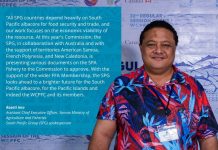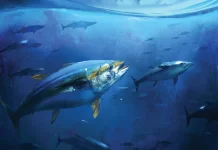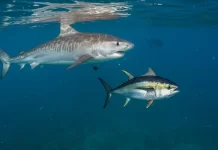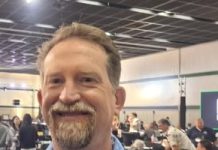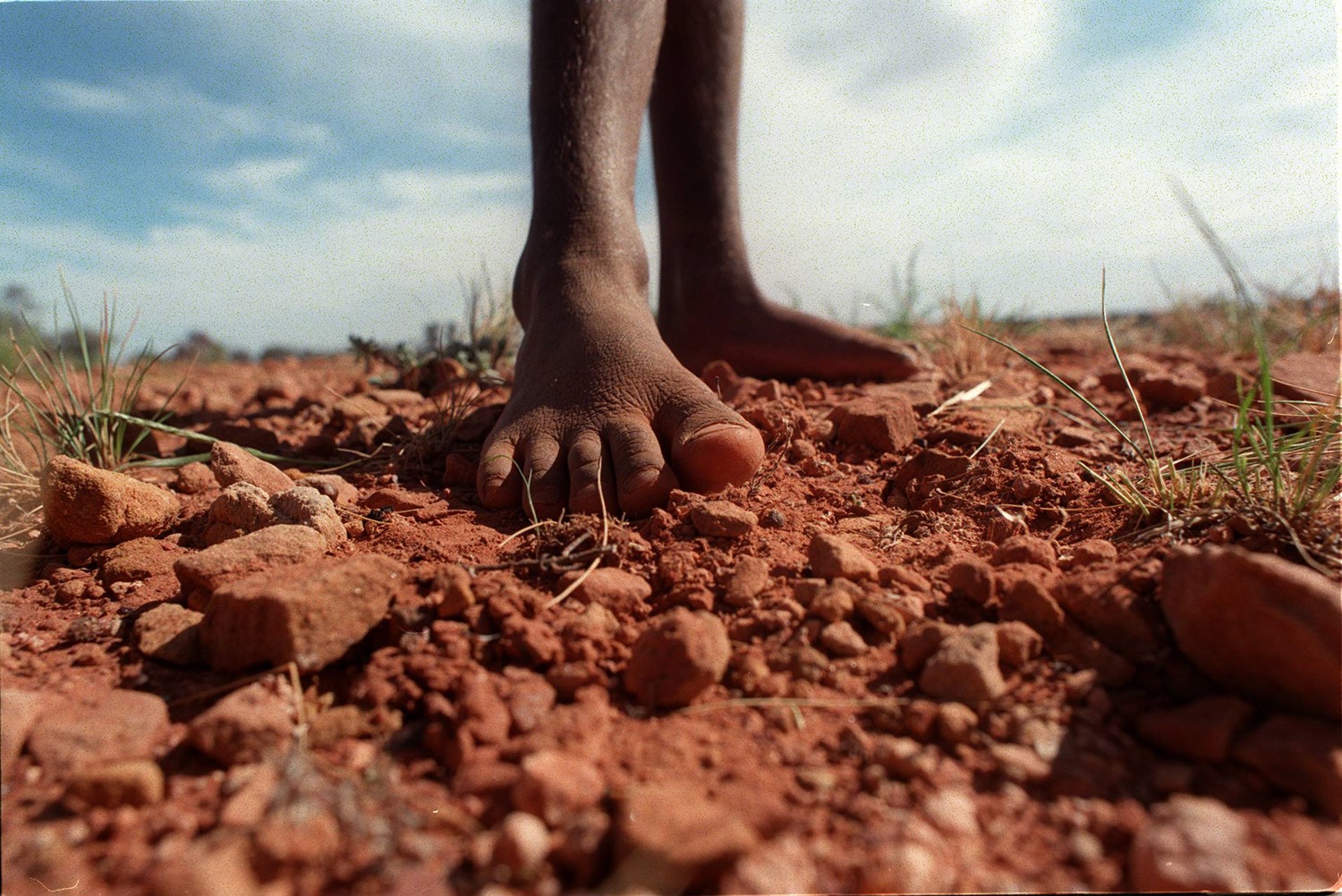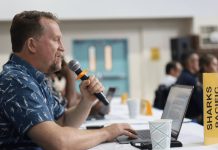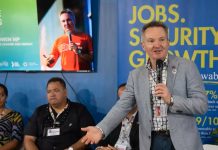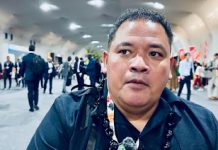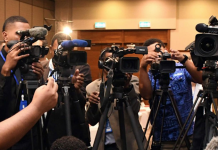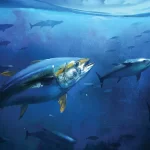By Nic Maclellan
Yami Lester was ten years old when a British atomic weapon, codenamed Totem 1, was detonated at Emu Field on 15 October 1953. The isolated test site in the desert of South Australia was downwind from his home at Wallatinna, and the wind carried dust into his eyes. Four years later, he lost all sight.
Before his untimely death in 2017, Lester’s autobiography recounted memories of the day when the Totem test sent a black mist across the desert.
“It was in the morning, around seven and I was just playing with the other kids,” Lester said. “That’s when the bomb went off. I remember the noise. It was a strange noise, not loud, not like anything I’d ever heard before. The earth shook at the same time; we could feel the whole place move. We didn’t see anything, though. Us kids had no idea what it was. I just kept playing.”
“It wasn’t long after that a black smoke came through,” he reported. “A strange black smoke, it was shiny and oily. A few hours later we all got crook, every one of us. We were all vomiting; we had diarrhoea, skin rashes and sore eyes. I had really sore eyes. They were so sore I couldn’t open them for two or three weeks. Some of the older people, they died. They were too weak to survive all of the sickness. The closest clinic was 400 miles away.”
It took years – and a Royal Commission – before the Australian and British governments would even begin to address the impact of UK nuclear testing on the Yankunytjatjara and Pitjantjatjara peoples.
Rushing to develop a nuclear arsenal and maintain a seat on the high table of international affairs during the 1950s, post-war UK governments sought vast, open sites to test atomic bombs and later thermonuclear weapons. After the first UK nuclear test in 1952, at the Monte Bello Islands off the coast of Western Australia, the lands of the Anangu people in South Australia were used to establish the Emu Field and Maralinga test sites.
Led by scientists like William Penney and Ernest Titterton, Britain conducted 12 atomic tests at the three test sites in Australia from 1952–57. These were followed by nine hydrogen and atomic bomb tests in 1957–58, at Malden Island and Christmas (Kiritimati) Island in the British Gilbert and Ellice Islands Colony (today, part of the atoll nation of Kiribati).
The UK program was endorsed and encouraged by then Australian Prime Minister Robert Menzies, without Cabinet or parliamentary approval. Little thought was given to the reality that the deserts and oceans of the southern hemisphere were not empty places, but home to indigenous peoples.
After the end of Emu Field and Maralinga tests, some Aboriginal people lived in contaminated zones for up to six years, while others had been relocated to coastal towns away from their traditional lands. The 1985 McClelland Royal Commission investigating the hidden history of Britain’s testing program recognised that the denial of access to land for displaced people “contributed to their emotional, social and material distress and deprivation.”
In October 2023, 70 years on from the first test of a British nuclear weapon on the Australian mainland, many people are still living with the health and environmental consequences. They are also still actively campaigning to gain recognition, health assistance and full compensation.
Kuntili June Lennon is a Yankunytjatjara, Antakarinya and Pitjantjatjara woman, who was just four months old when the Totem atomic bomb was detonated at Emu Field. Her mother Lallie and brother Bruce later received some compensation for ill-health caused by radioactive contamination. But for Lennon and other Aboriginal survivors, there are mental and emotional scars as well as physical ones.
“Every day I see my family and there so many problems with their health,” she told a webinar to mark the 70th anniversary. “Nobody thought about the effects that those bombs would have on our family, but I can tell you that our family is not a well family: we’ve had cancers, there’s been miscarriages and deformities. All we gained was a lifetime of illness and a lifetime of grief, watching our families pass on a long way before their time.”
“It is just so heartbreaking to live day by day knowing what the government did to the people of this country,” she added. “It’s also mental health. I wonder if a bomb dropped on you, how could you not suffer from mental health, anxiety and never-ending grief.”
Campaigning for justice
As the first generation of Totem survivors are ageing and dying, their descendants have picked up the torch to continue the campaign for recognition, compensation and clean-up.
Just weeks before Yami Lester’s death in 2017, his daughter Karina travelled from the deserts of South Australia to the United Nations in New York. She joined Pacific activists from Fiji, Marshall Islands and French Polynesia, to lobby more than 120 nations negotiating the new Treaty for the Prohibition of Nuclear Weapons (TPNW). To applause, Karina Lester presented a petition from indigenous groups around Oceania, calling for the treaty to include provisions that specifically assist nuclear survivors, with health care, support and reparations.
The nuclear abolition treaty entered into force on 22 January 2021, and its preamble now recognises “the disproportionate impact of nuclear weapon activities on indigenous peoples.” Uniquely for a disarmament treaty, TPNW Articles 6 and 7 require state parties to provide assistance to nuclear survivors and affected communities.
In June, Karina Lester and June Lennon travelled to Canberra as part of an Atomic Survivors Delegation, accompanied by former military personnel who staffed the test sites and ambassadors of the International Campaign to Abolish Nuclear Weapons (ICAN). The Anangu women met with Australian Foreign Minister Penny Wong and other parliamentarians, to describe the ongoing legacies of British nuclear testing. As Lester told MPs, “the scars are still felt on our country and the scars are still evident on our people.”
Delegation members also called for Australia to join its regional neighbours to sign and ratify the TPNW nuclear ban treaty: Aotearoa-New Zealand and ten Pacific island states and territories were amongst the first of the 69 states parties that have signed and ratified TPNW.
There were more than 310 U.S, UK and French nuclear tests at ten sites across Oceania between 1946 and 1996, alongside countless technical and medical experiments. For this reason, anti-nuclear sentiment remains strong across the islands region. On 28 September, the Assembly of French Polynesia passed a resolution endorsing the TPNW and calling on the French government to respect it as a norm of international law. France, like other nuclear weapons states, is opposed to the treaty and refuses to sign. But the Assembly resolution sends a pointed massage to Paris from the Ma’ohi people, who continue to endure the radioactive consequences of 193 French nuclear tests at Moruroa and Fangataufa atolls.
French officials were also angered when last August’s National Conference of the governing Australian Labor Party (ALP) agreed to send a government representative to observe the next TPNW Meeting of State Parties in November. Many Labor MPs have pledged support for signing TPNW, in line with party policy to ratify the treaty “after taking account of the need to ensure an effective verification and enforcement architecture; ensure the complementary interaction of the Ban Treaty with the longstanding Nuclear Non-Proliferation Treaty; and work to achieve universal support for the Ban Treaty.”
However, these conditions – combined with the opposition of key members of Cabinet – create enough loopholes to delay action on signature. There is growing pressure for the Albanese government to act, heightening by the decision to purchase nuclear submarines under the Australia-United Kingdom-United States (AUKUS) partnership.
Impact on soldiers
The advocacy of affected indigenous communities is matched by decades-long campaigns by nuclear veterans – at the time, young military personnel who staffed the test sites and faced exposure to hazardous levels of ionising radiation. Nearly 20,000 Australian and British soldiers, sailors and aircrew worked in and around test sites in Oceania, as the UK government tested nuclear weapons between 1952 and 1958.
Operation Totem was the first series of British atomic tests on the Australian mainland. Held at Emu Field, it involved two atmospheric nuclear tests, codenamed Totem 1 (15 October 1953) and Totem 2 (27 October). The Royal Air Force, Royal Australian Air Force (RAAF) and US Air Force all deployed aircraft to Emu Field, to monitor the tests and collect samples of radioactivity, as the mushroom cloud rose and spread across the desert.
For the Totem 1 test, RAF pilot Geoffrey Dhenin captained a Canberra bomber that flew through the mushroom cloud to gather radiation samples, so UK scientists could determine the explosive yield of the weapon. After testing the level of radioactivity with sensors mounted on the wing, Dhenin made three passes through the mushroom cloud. On return to base, the aircraft was surveyed and found to be extensively contaminated with fallout.
Despite shielding on the aircraft, Dhenin and the two other crew members received high doses of gamma radiation, far above the permitted level. Although they were scheduled to perform the same role for the Totem 2 test a fortnight later, the crew were withdrawn from service.
To this day, the British government continues to claim that safety preparations and the conduct of the tests minimised radioactive fallout. But for all the UK tests, British and Australian groundcrew as well as pilots were exposed to significant levels of radiation. Aircrew scrubbed downs the planes after each test, using mops and buckets to remove contamination, with little or no protective gear.
Bryan Young was one of the ground crew sent to scrub down a plane that had transited the radioactive mushroom cloud: “We were cleaning off barrier paint above me and water came off the back of the wing. I was only wearing cotton whites so, of course it went straight through. Bearing in mind that it was contaminated water coming off, I wasn’t a very happy person underneath. But we were all too busy at the time to do much about it.”
Today, decades later, many survivors suffer from serious illnesses that they attribute to exposure to hazardous levels of radiation. The ageing participants are also fearful about possible intergenerational effects that may threaten the health and wellbeing of their children and grandchildren.
The remaining British, Australian, NZ and Fijian nuclear veterans, now into their 80s, are campaigning for compensation from the UK Government. Despite this, UK authorities continue to resist full reparations. The UK Ministry of Defence and successive British governments have systematically resisted legal cases launched by veterans of the British tests in Australia and Kiribati.
Alan Owen is the former chair of the British Nuclear Test Veterans Association (BNTVA), whose father served on Kiritimati. Through the LABRATS network, Owen is calling on the UK government to release medical records and open the archives of ministries involved in the tests.
This year, after a long campaign by British nuclear veterans, the UK government announced it will grant a medal to all service personnel who participated in the testing programme. For Alan Owen, it’s a start, but little more.
“The veterans believe that a medal was given begrudgingly, and this has been shown by the failure to organise an initial event to honour their service, instead sending medals in the post,” he said. “We always wanted to use medallic recognition as the first step and that is why we have continued to work on further recognition. Many are pleased that they now have some recognition, but they want an apology and formal compensation.”
“We stand shoulder to shoulder with the indigenous community in Australia, and everyone who was affected by the British nuclear testing program and feel the effects today,” he added. “Seventy years is too long to wait. Seventy years is too long to keep fighting for the truth, for formal recognition, and for proper compensation.”
Silencing voices and closing the archives
Sadly, the anniversary of the first Totem test fell on the day after a majority of Australians voted No in a referendum to establish The Voice – a proposal for an indigenous advisory body to government and parliament on matters affecting the land, welfare and culture of Aboriginal and Torres Strait Islands peoples.
Such silencing of indigenous voices has been a central element of the hidden history of nuclear testing in Oceania. The official literature on the nuclear era features the generals and scientists who led the atomic testing programs, rather than the people who live with the consequences.
Associate Professor Elizabeth Tynan is a former science writer and leading historian of British nuclear testing in Australia. Her book “Atomic Thunder” was awarded the Prime Minister’s literary award for Australian history, as she documented the legacies of atomic testing at Maralinga during Operation Buffalo and Operation Antler. Her latest study on UK nuclear colonialism, “The Secret of Emu Field”, focusses in detail on the health and environmental consequences of Operation Totem.
Drawing on extensive archival research, Tynan’s book details the casual way the Menzies government allowed Britain to use “a tiny slice of a vast swathe of beautiful and wild central Australian territory” for nuclear testing, noting “the fact that this pristine land was so casually handed over to a foreign power to test weapons of war speaks volumes about the particular bonds of colonialism.”
Seventy years ago, Britain was rushing to develop atomic weapons before the US and Soviet Union could agree on a moratorium on the atmospheric testing of atomic and hydrogen bombs. In response, the Emu Field facilities were quickly thrown together, in an area traversed by indigenous people and near to communities within range of plumes of radioactive fallout. The rush to hold the tests in October 1953 ignored the way that indigenous Anangu were moving around the area’s waterholes at that time, during dingo pup hunting season.
Tynan argues that “the callous disregard the British displayed towards the local inhabitants of the region had the same effect as if they had overtly sought to use Aboriginal people as experimental subjects.” She also notes that the UK scientific team misjudged the yield of the two Totem tests, and “the meteorology at the site was not up to the task of managing the complex process of predicting and tracking atomic clouds – both Totem clouds went rogue once they had been detonated.”
The atomic tests in Australia were a crucial prequel to the development of the British hydrogen bomb, codenamed Operation Grapple, when the UK Government decided to follow the United States and the Soviet Union in the development of more powerful thermonuclear weapons. In this military deployment, at Malden and Christmas Islands in the central Pacific, thousands of British service personnel were joined by hundreds more New Zealand sailors, Gilbertese labourers and members of the Fijian Military Forces. As in Australia, many face illness and early death related to their participation in the Kiribati tests.
Researchers are campaigning for greater access to nuclear archives, to reveal hidden history but also to seek evidence that might vindicate the claims of civilian and military survivors about health and environmental impacts.
However, as she prepared her award-winning histories, Tynan faced a challenge common to many researchers of the nuclear era. The Cold War secrecy that surrounded the tests in the 20th century continues to this day. Key documents that are crucial to understand the history of the tests are buried in the archives or deliberately withheld by authorities. Academics and researchers studying the British tests have been hampered by the withdrawal of key files from public access at the UK National Archives.
“Most of my research is based on archival records and one of the things that always strikes me is the sheer arrogance and cruelty that comes through from the architects of the British test program,” Tynan said. “What strikes me particularly is the lack of curiosity and the indifference that the test authorities had towards the people whose land this was. They were detonating bombs in people’s homelands, but the British test program was notable for its lack of respect for safety generally and the lack of safety protocols.”
Tynan’s history of the Totem test looks at the stories of ‘puyu’ or black mist from indigenous survivors – an issue of extensive debate at the Royal Commission, with William Penney and other scientists disputing any danger. Drawing on analysis by meteorologists and anthropologists, Tynan navigates the conflicting evidence, concluding “the black mist was not just a physical phenomenon but a psychological one that shows the damage in populations altered by the possibility of unknown and unquantifiable harm.”
Waste dumping
In the 1990s, Aboriginal women in South Australia formed the group Kupa Piti Kungka Tjuta and the campaign Irati Wanti (The Poison – Leave It), to oppose government proposals to create a nuclear waste dump on their land. More recently, a Federal Court ruled in favour of the Barngarla Determination Aboriginal Corporation, with a decision last July halting plans for a low-level nuclear waste dump at Kimba, on South Australia’s Eyre Peninsula.
Now, under the AUKUS partnership, Australian Defence Minister Richard Marles has announced that, in future decades, the spent high-level waste from the reactors of proposed AUKUS nuclear submarines will be stored forever on “defence land.” Given Australia and Britain have not managed the environmental legacies of nuclear testing and experiments from the 1950s and 1960s, Anangu people are worried that their land will be targeted once again as a sacrifice site for the nuclear industry.
Indigenous culture is still strong on country, and for Karina Lester, past radioactive contamination of the South Australian desert should not justify further attempts to store high level wastes on Anangu land.
“Knowing the struggles we’ve gone through and the fights that we First Nations peoples have had in South Australia, we’re constantly having to voice these concerns openly to the community,” she said. “I really have a fear with Australia’s role around AUKUS – is my state of South Australia going to be pressured to be the nuclear waste dump of the world?”
On 15 October, a coalition of church and civil society organisations released a public statement to commemorate the 70th anniversary of the first Totem test, calling for urgent nuclear disarmament: “The trauma of the past cannot be undone, but we have the desire, ability and responsibility to create a peaceful and safer future.”
Endorsed by international partners such as the Pacific Conference of Churches, the statement calls on the Australian government to join its Pacific neighbours by signing and ratifying the nuclear ban treaty: “As Australia pursues nuclear-powered submarines under the AUKUS agreement, it is now more vital than ever for our nation to demonstrate its commitment to nuclear non-proliferation and disarmament by joining the Treaty on the Prohibition of Nuclear Weapons.”
Some voices have been blown away in the wind, but others still cry for justice.
SOURCE: ISLANDS BUSINESS/PACNEWS


